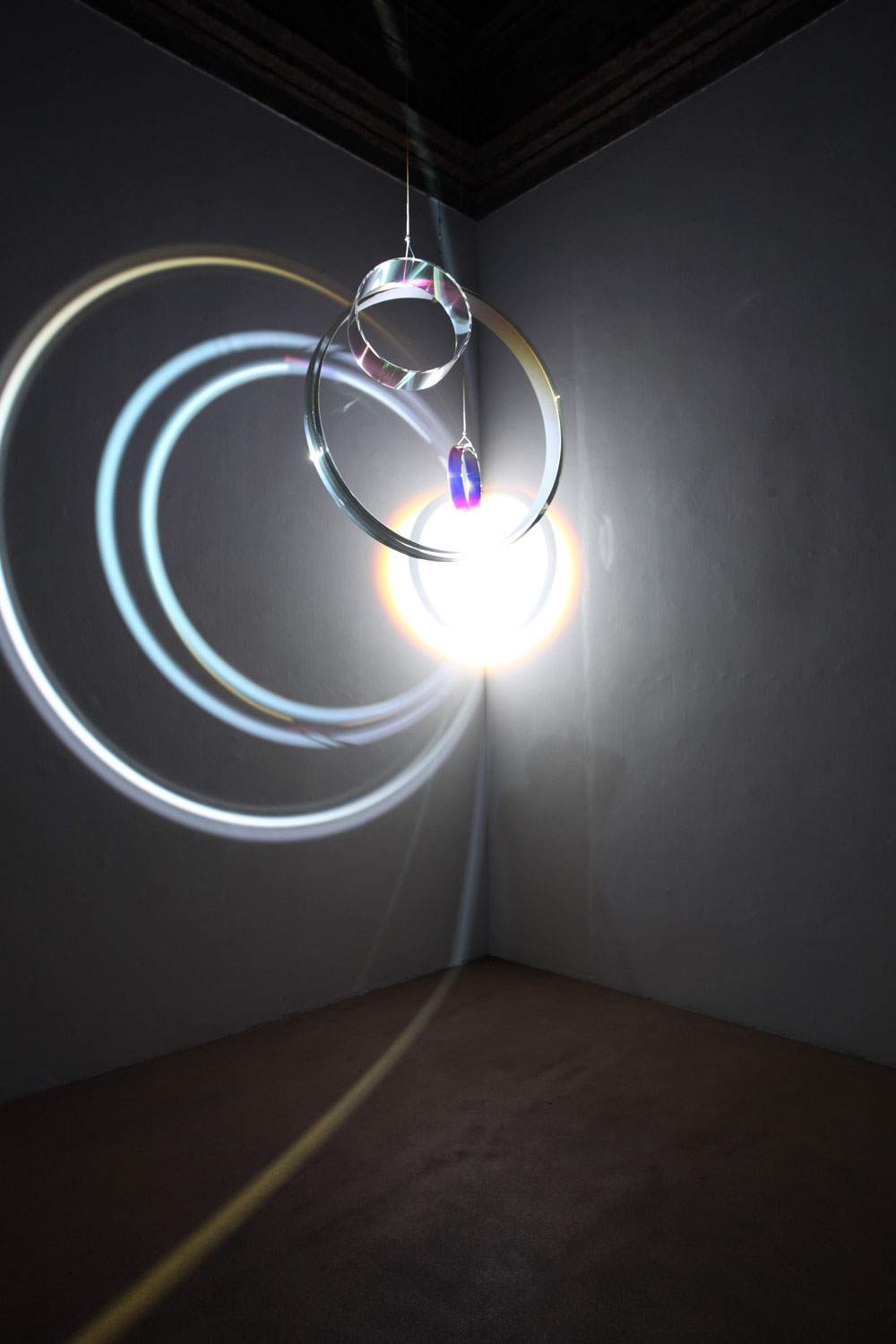The Complesso Monumentale di San Francesco in Cuneo hosts from Oct. 24, 2020 to Feb. 14, 2021 the exhibition E luce fu, curated by Carolyn Christov-Bakargiev and Marcella Beccaria, with curatorial advice from Marianna Vecellio for Renato Leotta’s project, and promoted by Castello di Rivoli Museo d’Arte Contemporanea and Fondazione CRC.
The protagonists are Giacomo Balla, Olafur Eliasson, Lucio Fontana and Renato Leotta, with their works all focused on light, belonging to the Collections of the Castello di Rivoli Museo d’Arte Contemporanea.
The works of the four featured artists are installed in relation to the spaces of the exhibition venue, creating an immersive and sensory journey. At the center of the central aisle is the historic work by Giacomo Balla (Turin, 1871 - Rome, 1958) Feu d’artifice(1917), which the artist made during his years of joining Futurism. First presented on April 30, 1917 at the Teatro Costanzi in Rome, the work consists of a true theatrical spectacle in which Balla, to the notes of Igor’ Stravinsky and the direction of Russian ballet impresario Sergey Djagilev, activates a scenario whose protagonists are luminous geometric volumes. Pyramidal shapes and pointed parallelepipeds, whose wooden structure is covered with painted and colored fabrics, with electric lights inside, rhythmically operated with unprecedented movement effects. The elements represent, as Balla explained, “the moods of the fireworks” that Stravinsky’s music had suggested to him. The performance lasts only three minutes, in keeping with the principles of a theater born of intuition and capable of condensing multiple situations and ideas into a few moments, as defined by Filippo Tommaso Marinetti.
Lucio Fontana (Rosario di Santa Fe, Argentina, 1899 - Comabbio, Varese, 1968) is represented in the exhibition by Ambiente Spaziale, 1967 (1981). The light from Wood’s lamps reveals the double linear trajectory of circles painted in phosphorescent colors. The viewer, according to the artist’s stated intentions, is in the environment face-to-face with himself: all the senses concur to make perception a total experience. Fontana’s environmental work stands as a first realization of the projects enunciated in the manifestos of the Spatialist movement, which the artist founded in Milan in 1947.
The church apse is enlivened by the play of light and shadow in The sun has no money (2008) by Olafur Eliasson (Copenhagen, 1967). The artist places the subjectivity of each visitor at the center of his research, and from the beginning of his artistic career he has been investigating light as a crucial theme in the field of knowledge of reality. Eliasson often refers to his works as “machines”: the true work of art is the product of the encounter between objects physically arranged in space and the uniqueness of the individuals who perceive them. In the case of the installation in the exhibition, Eliasson uses two theater spotlights, aiming their light beams at two structures consisting of concentric rings made of acrylic material. Hanging from the ceiling and operated mechanically, the rings cast multiple shadows in the exhibition space, producing circles of colored light that draw novel shapes along the walls of the space. In The sun has no money, he leaves visible the mechanical and electrical elements that make up the installation, inviting visitors to question the modes of perception achieved.
Renato Leotta ’s (Turin, 1982) work, Sun (2019-2020) runs along the entire environment of the church: it consists of old headlights of decommissioned cars installed to illuminate significant details of the building’s architecture and interior decorative scheme. Beginning with research initiated in 2019, Leotta recovers lights from various vehicles, reconfiguring them as agents capable of replacing traditional lighting systems. Leotta thus questions the social changes that have occurred in several parts of the Piedmont region, which, from being a center linked to industry until the late 1990s of the last century, has turned toward the production of “contemporary entertainment culture,” according to the artist himself.
“In Western culture,” says Carolyn Christov-Bakargiev, director of the Castello di Rivoli Museum of Contemporary Art, “light has always been a symbol of clarity and pure knowledge, of that supreme fineness of thought to which every follower of Plato should aspire. But something irrational and free is to be found in the experience of the dazzle experienced instead during ecstasy, also part of our culture and minutely described by Dante in the last canto of Paradise and later also by some saints, such as Teresa of Avila (1515-1582) in her diaries. Today, the light from the screen of our cell phones and computers dazzles us in a sense far removed from both clarity of thought and ecstasy. Through an exhibition of artworks made with pure light as matter, we reflect on the real world, enveloped in electromagnetic rays.”
For info: fondazionecrc.it
Hours: Tuesday through Saturday from 3:30 p.m. to 6:30 p.m., Sunday from 10:30 a.m. to 6:30 p.m. Free admission.
Image: Olafur Eliasson, The sun has no money (2008; stained glass filter, mirror, steel cable, electric motors, spotlights, tripods, wall mounts, dimensions variable; Rivoli, Castello di Rivoli Museo d’Arte Contemporanea). On loan from Fondazione per l’Arte Moderna e Contemporanea CRT. Courtesy Castello di Rivoli Museo d’Arte Contemporanea, Rivoli-Turin. Photo Paolo Pellion.
 |
| And light it was. Works by Balla, Fontana, Eliasson and Leotta in Cuneo. |
Warning: the translation into English of the original Italian article was created using automatic tools. We undertake to review all articles, but we do not guarantee the total absence of inaccuracies in the translation due to the program. You can find the original by clicking on the ITA button. If you find any mistake,please contact us.